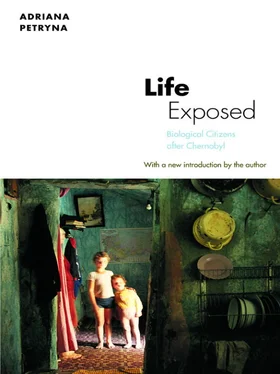Yet the American team, unlike the Soviet team, was uninterested in long-term assessments of the health impact of Chernobyl. During our 1996 interview, Gale told me that his interests were short-term, and that the accidental situation offered his team a ready opportunity: “The Chernobyl accident for the firemen at the power plant was exactly what we do at the clinic every day. Potentially, there were patients with [leukemic] cancer exposed to acute whole body irradiation.”
Gale told me that the way Guskova selected patients at the accident site was, in part, arbitrary. This arbitrariness generated a group of over four hundred patients. He said that his initial impulse was to help “what was not a clear number of acute radiation victims…. Actually, we brought genetically engineered molecules in here that had never been given to humans before, one of these cloned hematopoietic growth factors [rhGM-CSF]. [25] Recombinant human granulocyte-macrophage colony-stimulating factors or (rhGM-CSF).
We were working with it for about two years, for Sandoz actually.” The bone marrow transplants were a venue for testing of a new product. The genetically engineered molecule was believed to be useful for treating bone marrow failure by accelerating the recovery of stem cells and other blood products. “We used hematopoietic growth factors subsequently in an accident in Brazil. The point, another idea I had at the time, was that it wasn’t just useful for transplanting. We could use these growth factors for a whole bunch of things.” Ethical standards in the United States allow for untried experimental treatments if a patient’s life expectancy is minimal. That there was some uncertainty regarding the acute radiation sickness status of patients at the disaster site does raise questions about the ethics of research in this instance. [26] The testing of the molecule, according to the scientist, had the approval of the U.S. FDA.
In the United States, the in vitro activity of GM-CSF had been investigated intensively. [27] Donahue et al. 1986; Monroy et al. 1986.
Little was known, however, about the activity of this protein molecule in vivo. Animal research had gone from murine to primate model testing. In monkeys lethally irradiated (900 rem), GM-CSF had been shown to promote bone marrow recovery by initiating stem cell growth. The product had not yet been tested on humans because of federal laws banning human experimentation (in this case, subjecting humans to lethal radiation doses). The American team ran GM-CSF trials on patients to see whether the molecule could stimulate recovery where recovery would otherwise be improbable.
When I asked Gale whether he felt that the product was successful, he said:
It’s very hard to say. All I can say is that we had about 499 people in the hospital, 29 died. So we were either incredibly skillful or incredibly lucky. I would favor incredibly lucky…. And most of the deaths we did have were not from bone marrow failure, which was the thing we were trying to treat. The deaths were mostly from burns or other injuries, not related to radiation. The same guy who was in the middle of the fire was the guy who got irradiated and who had steam fall over his head. People don’t understand that really, you can save them from one thing, only to die of another, and these things are tending to occur in the same people.
From his point of view, causes of death associated with the disaster except bone marrow failure became scientifically insignificant.
The Soviet-American team published the results of the transplants in the Journal of American Medical Association . Out of the thirteen transplant recipients, five died of burns, three of interstitial pneumonitis, two of graft-versus-host disease, and one of renal failure and respiratory distress. Two survived. The Soviet team later criticized Gale’s drive to conduct bone marrow transplants. The team published in Hematologiia I Transfuziologiia , without including the American participants’ names in the list of contributors. The American team had introduced biological dosimetry using biological markers (such as chromosome aberrations of peripheral blood lymphocytes) rather than Guskova’s symptom-based markers of estimating dose exposure. The Soviets reported that out of the thirteen, at least two who underwent bone marrow transplants died as a result of the inaccuracy “inherent in estimating doses by the use of biological parameters.” Guskova told me that Gale was a “good hematologist but he projects knowing more than he does.” The article criticized technological quick fixes and reaffirmed the value of the Soviet clinical model based on long-term observation and treatment of syndromes.
The success or failure of GM-CSF was never commented on directly in subsequent scientific articles. Soviet administrators, as documents show, were worried about sensationalism stemming from this human research ( Chornobyl’ska Tragediia 1996:214). Judging from the lack of follow-up studies, the whole matter was dropped. But the authority of these initial interventions remained uncontested. A joint meeting in August 1986 between Soviet scientists and members of the International Atomic Energy Agency confirmed the scope of injury as being limited to the 237 cases of ARS. Thirteen patients received bone marrow transplants. Eleven died. In the next months, seventeen more ARS patients died. Two others were reported to have died from injuries unrelated to radiation exposure. By September, the death toll was thirty-one. The joint medical team, in its 1986 report to the IAEA, did not try to minimize the consequences of the accident. By 1987, neither Gale nor Guskova and colleagues commented on the possibly greater general health impact of the accident (Medvedev 1990:165).
In her clinic today, Guskova treats “mainly local skin burns.” She also screens claims of radiation illnesses by all nuclear workers throughout Russia. Guskova told me that she was a strong advocate of rehabilitation, and that typically her patients “recovered within two years only if patients help in the process.” She expected patients to “react and work.” She made a distinction between the workers she immediately registered as sick and the subsequent six hundred thousand workers sent into the Zone. Her original patients could recover. Her new patients “are psychological.” She blames these patients for impeding physicians’ efforts in the recovery process. “The new patients don’t wish to recover.” For her, the real cause of their illness is not radiation but the loss of a work ethic and of lichnost —a Russian word denoting a virtuous personality and often associated with a desire to work. She connected the illnesses of these new patients with a “struggle for power and material resources related to the disaster” (1995:23) and downplayed their symptoms as nonradiogenic. She summarized their medical particularities by stating that “there have been no new cases of ARS; but social, psychological, economic problems facilitate psychosomatic realizations that result in light changes in cardiovascular regulation and psychosomatic and neurotic realizations.” In Guskova’s Soviet model of health, such “realizations” become the readable equivalent of social vice and individual weakness; the desire to work and the possession of lichnost’ counteract any individual tendencies toward physiological vulnerability.
For his part, Gale went further in annulling the medical significance of the event. During our 1996 interview he noted that with the exception of those initial ARS patients he attempted to treat, from a medical point of view, “Basically nothing happened here. Nothing happened here… and nothing is going to happen here.”
• • •
In completing their containment mission, international experts and Soviet administrators had internationalized the problem of radiation protection. In generalizing, they redefined the problem in abstract terms, removing it from the human horror of the immediate context. Only the experts, they claimed, could make objective sense of the situation by constructing parameters of biological risk and safety, assessing levels of individual and populationwide exposure, and, by extension, arbitrating emergent claims of illness. In the process of this internationalization, an internalization process ensued: the narrative of the human effects and the number of workers it took to contain environmental contamination at the accident site was relegated to the domestic sphere of Soviet state control.
Читать дальше












